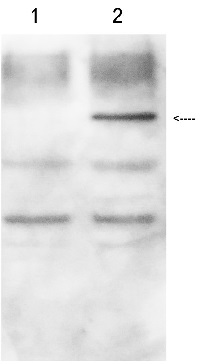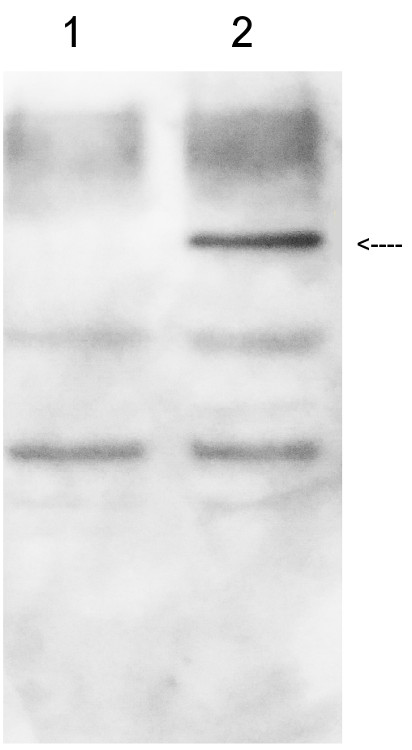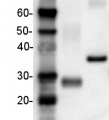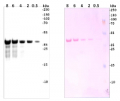1

Anti-GUS | Beta-glucuronidase
AS16 3689 | Clonality: Polyclonal | Host: Rabbit | Reactivity: GUS from Escherichia coli
- Data sheet
-
- Product Info
-
Immunogen: KLH-conjugated synthetic peptide derived from Escherichia coli GUS protein at amino acid 358.
Host: Rabbit Clonality: Polyclonal Purity: Serum Format: Lyophilized Quantity: 50 µl Reconstitution: For reconstitution add 50 µl of sterile water Storage: Store lyophilized/reconstituted at -20°C; once reconstituted make aliquots to avoid repeated freeze-thaw cycles. Please remember to spin the tubes briefly prior to opening them to avoid any losses that might occur from material adhering to the cap or sides of the tube. Tested applications: Immunolocalization (IL), Western blot (WB) Recommended dilution: 1 : 10 000 (WB) Expected | apparent MW: depends upon a MW of a protein which is expressed with GUS
- Reactivity
-
Confirmed reactivity: GUS
Not reactive in: No confirmed exceptions from predicted reactivity are currently known - Application Examples
-
Application example

100 µg of total protein from Arabidopsis thaliana wild-type (1) and transgenic plants expressing GUS under HRT promoter (2) were extracted with write buffer containing 50 mM Tris-HCl pH 7.5, 150 mM NaCl, 10 mM MgCl2, 5 mM EDTA, 10% glycerol, 0.1% NP-40, 0.1% protease inhibitor cocktail . The proteins were denatured by boiling for 5 minwere separated on 10% SDS-PAGE and blotted 30 min to PVDF using tank transfer. Blots were blocked with TBST containing 5% non-fat dry milk for 1h at room temperature (RT) with agitation. Blot was incubated in the primary antibody at a dilution of 1: 10 000 for 2h at RT with agitation in TBS-T. The antibody solution was decanted and the blot was rinsed briefly twice, then washed 3 times for 15 min each in TBS-T at RT with agitation. Blot was incubated in secondary antibody (anti-rabbit IgG horse radish peroxidase conjugated) diluted to 1:10 000 in for 1h at RT with agitation. The blot was washed as above and developed with Clarity MAX (Bio-RAD). Exposure time was 10 seconds.
Courtesy of Dr. Pradeep Kachroo, University of Kentucky, USA - Additional Information
-
Additional information: This antibody will not work with pCAMBIA vectors due to mutation starting at amino acid position 358 - Background
-
Background: GUS (Beta-glucuronidase) is an enzyme which when incubated with colorless or non-fluorescent substrates, can catalyze reaction of their transformation into coloured or fluorescent products.
- Product Citations
-
Selected references: Mastsushima and Matsuo (2023). Removal of plant endogenous proteins from tobacco leaf extract by freeze–thaw treatment for purification of recombinant proteins. Plant Sci. 2023 Dec 10:339:111953.doi: 10.1016/j.plantsci.2023.111953.
Xiumei et al. (2022) Pathogenesis-related protein 1 suppresses oomycete pathogen by targeting against AMPK kinase complex,Journal of Advanced Research, 2022, ISSN 2090-1232, https://doi.org/10.1016/j.jare.2022.02.002.
Xiao et al. (2022) An amino acid transporter-like protein (OsATL15) facilitates the systematic distribution of thiamethoxam in rice for controlling the brown planthopper. Plant Biotechnol J. 2022 Jun 9. doi: 10.1111/pbi.13869. Epub ahead of print. PMID: 35678495. (Immunolocalization)
Nizkorodova et al. (2020). The Effect of Translation Promoting Site (TPS) on Protein Expression in E. coli Cells. Mol Biotechnol (2020). doi.org/10.1007/s12033-020-00251-1
Nikorodova and Isakov (2019). New insights into the mechanism of action of e-element enhancer in E.coli. Eurasian Journal of Applied Biotechnology 2/2019 - Protocols
-
- Reviews:
-
This product doesn't have any reviews.



